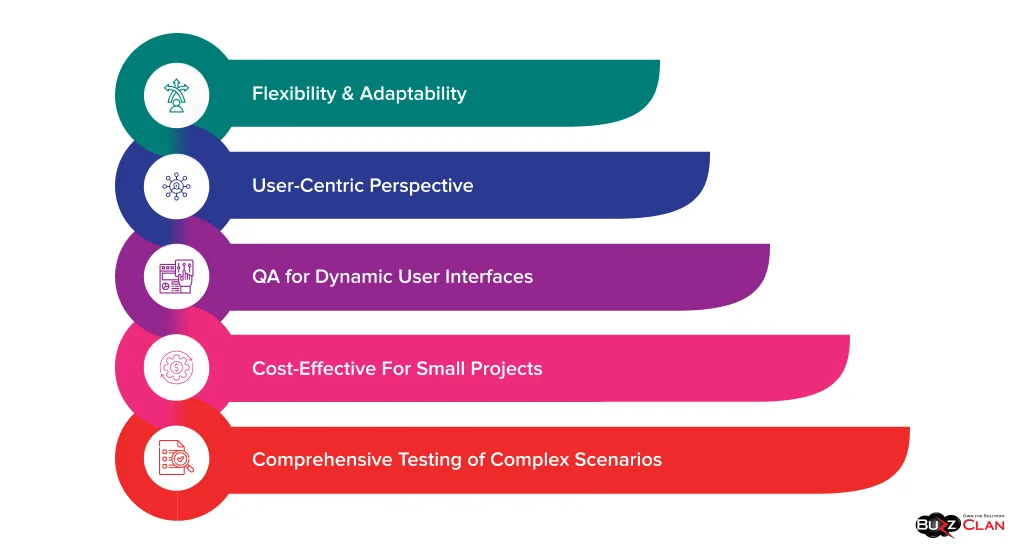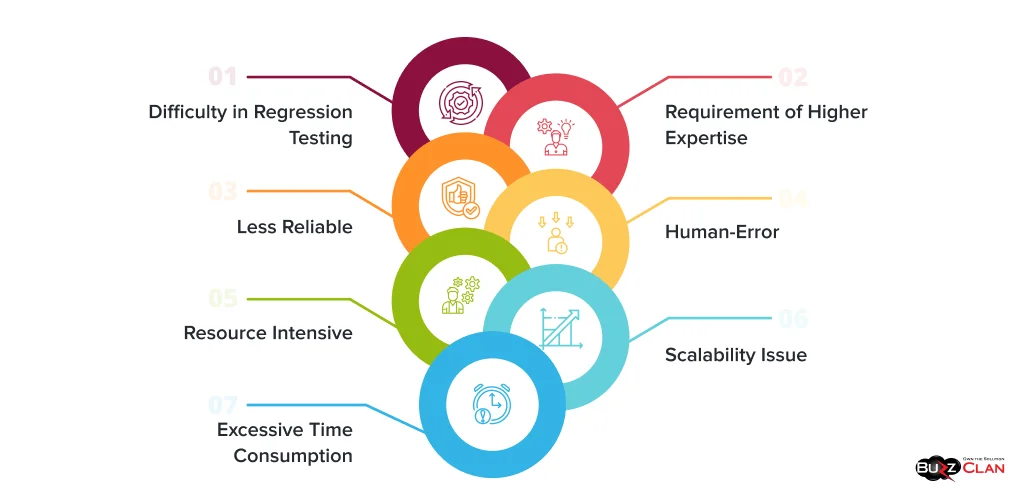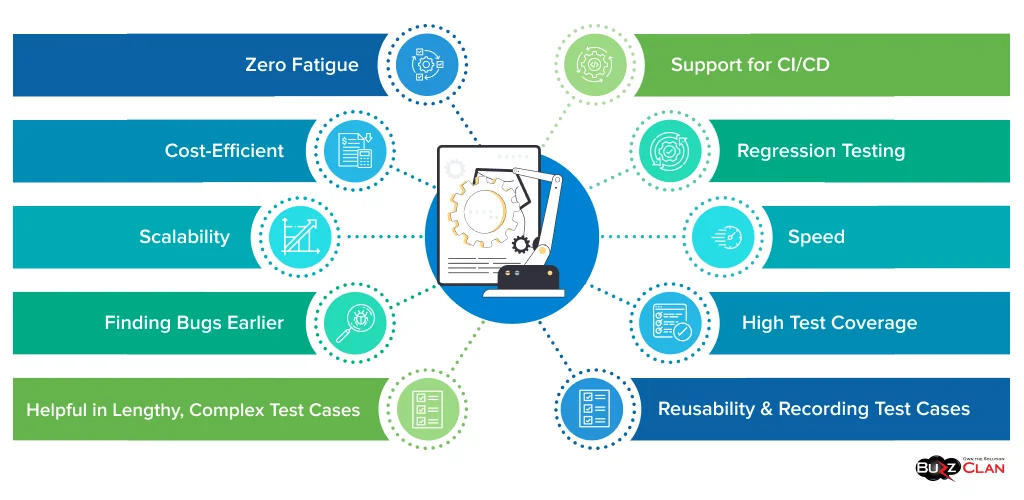Manual Testing vs Automation Testing: Your Complete Decision Guide
Kumar Khurana
Dec 19, 2024
The Software Testing industry is worth $51.8 billion in 2023 and is estimated to reach $109.5 billion by 2027. This whopping industry is currently undergoing a debate about manual and automated testing, both of which are integral parts of mobile app testing. Let’s end the debate today in this article.
What is Manual Testing?
Manual testing is when human Quality Assurance testers, i.e., quality analysts, test the essential features of software or applications before they go live. Its primary purpose is to catch early feature issues or bugs without using automation, i.e., testing tools.
In manual testing, testers create test cases, test them, and then create a full-fledged test report. This takes time, but it helps with in-depth analysis and testing. Manual testing has an advantage over any other type of testing because testers do usability tests that help assess the app from an end-user perspective.
Advantages of Manual Testing

With a market size of USD 90.39 billion by 2031, manual testing retains many advantages over other types of software testing. Here is the list of advantages of manual testing. Let’s uncover them:
User-Centric Perspective
Manual testing is done by human testers, also known as quality analysts. They test the software as external users, similar to regular users who will ultimately use it. This testing utilizes human intuition and creativity, discovering unexpected bugs that might have gone unnoticed by automated testing. This adds a human touch to the testing process, leading to more in-depth and user-centric perspective testing.
Cost-Effective For Small Projects
Manual testing is cost-effective and can save huge resources for small projects. Automation testing requires a heavy initial investment.
Flexibility & Adaptability
Testing scenarios can be easily changed in manual testing because testers are more adaptable to changes in testing approaches. Moreover, manual testing is flexible when making short-lived applications due to the application’s short lifespan. Automating test scripts on such types of projects is unnecessary in this scenario.
QA for Dynamic User Interfaces
Manual testing can be considered while testing applications with frequently changing GUI (graphical user interface). Humans can effectively assess graphic or visual elements or interactions more efficiently.
Comprehensive Testing of Complex Scenarios
Automation can evaluate software, but manual testing can do it more comprehensively. For more complex solutions, manual testing can test several user paths and edge cases in which automation can neglect, overlook, or be incompetent.
When to Perform Manual Testing?
After knowing how manual testing benefits businesses and projects, let’s understand under what situation you should use or perform manual testing:
Short-Lived Projects
Manual testing, with its flexibility and adaptability key features, is highly preferable to short-lived projects whose lifespan is short. The changes in these types of apps or software can be easily and effectively tested without hefty investments in automated testing tools.
Testing End-User Usability
When the application is tested for end-users, human testers can bypass automation testing. They can effectively test the software as end-users, facilitating more intuitive and accessibility.
Agile Environments
Due to its flexibility, manual testing is a great way to test essential functionalities in agile environments where features and app changes are frequently made. Testers can adapt to changing test cases, aiding in quick and in-depth testing better than automated tools.
High-Risk & Complex Scenarios
Quality analysts can outperform other types of testing in some high-risk or complex scenarios. They have the keen eyes to spot errors or issues thoroughly in several interactions where automated testing is lacking. Testers ensure, with their intellect and human cognition, that multiple user paths or edge cases are tested accurately.
Integration Testing
This type of testing can be used to determine how new systems or functionality interact with several modules when they are integrated into the software.
Post-Deployment Verification
Post-deployment verification involves verifying the production environment. Catching bugs or errors arose due to the transition to live use during the development process.
Challenges of Manual Testing

There are some limitations to manual testing; some of these are:
Less Reliable
Manual testing does not offer 100% test coverage assurance for the application or software. It is not considered reliable because human testers can oversee some errors. In the end, they are humans, and humans can make mistakes.
Requirement of Higher Expertise
Features with high complexity require higher expertise. Junior testers cannot test complex versions, whereas automated testing is different.
Excessive Time Consumption
Human testers can take more time than other types of testing. They can deeply assess the functionalities, taking into account errors and issues. Moreover, manual testing cannot be recorded or reused.
Human-Error
Manual testing always involves risk and the possibility of human error. Human error can result in missing faults by overlooking test cases or misinterpreting requirements.
Resource Intensive
We all know that humans are resource-intensive. A large number of testers will be required to cover a large number of test cases, leading to resource allocation and budgeting challenges.
Scalability Issue
Testing can become hectic when applications gradually become complex, resulting in emotional/physical fatigue for quality analysts.
Difficulty in Regression Testing
Performing regression tests manually may be laborious and unproductive, and it is also easy to omit tests, especially with the frequent addition of new features and modifications.
What is Automation Testing?
In automation testing, testers use testing tools and methods to automate the predefined testing cases of software and applications, ensuring quality and stability. This process involves creating test scripts, which make the testing quick and efficient compared to manual testing.
With an expected industry value of USD 149.45 billion by 2033, automation testing is mainstreamed among businesses amid AI trends in quality assurance and its ability to reuse test cases many times for repetitive tasks.
Advantages of Automation Testing

Automation testing has various advantages over manual testing for businesses and projects. Some of these are:
Scalability
Automation testing relies on tools and techniques to automate test cases. Automated tools can carry out the testing process effectively and efficiently if a project grows and expands at scale.
Cost-Efficient
A hefty amount is invested in automation tools and recruiting testers at the beginning of the testing process. However, it saves businesses a lot of money and time in the long run.
Speed
Since minimal human intervention exists, the testing process is carried out at machine speeds. The lack of human efforts and complexions accelerates the overall speed of the testing process.
Helpful in Lengthy, Complex Test Cases
In lengthy and complex test cases, automated testing outperforms manual testing, as performing complex, challenging, and impractical tests by a human would take a lot of time and effort. Making it highly preferable for performance and load testing.
Finding Bugs Earlier
It allows teams to adopt a shift-left testing approach by integrating testing in the development process’s starting phases. This helps them find bugs earlier.
Reusability & Recording Test Cases
Test cases can be recorded and reused for repetitive testing of features, functionalities, or reliability.
Regression Testing
Helpful in repetitive tasks like regression testing, assisting in finding more bugs in less time.
High Test Coverage
The test coverage is high in automation testing because the tools ensure that not even a single unit is left to test, facilitating complete coverage.
Support for Continuous Integration/Continuous Deployment (CI/CD)
It is beneficial in CI/CD environments where frequent changes exist because of its ability to carry on rapid testing cycles. Moreover, it can also be employed in deployment pipelines, ensuring that every new feature is first tested and released.
Zero Fatigue
With minimum human intervention in testing, humans don’t get fatigued and overwhelmed due to tasks and work. The risk of human errors is also negligible.
When to Perform Automation Testing?
Organizations should adopt and perform automation testing in these case scenarios:
Regression Testing
Automation testing is highly considered when doing repetitive tasks, such as regression testing. It ensures that newly added codes do not interfere with other functionalities.
Limited Resources
Organizations with fewer or limited resources opt for automation testing because this methodology involves fewer human testers.
Smoke Testing
Automation in smoke testing can detect errors earlier in the development process, helping verify critical functionalities are checked effectively.
Basic Functionality Testing
Automated testing is suitable and preferable for basic functional testing where the outcomes are expected to be simple and consistent, so human intelligence and cognition are used appropriately.
Long-Term Projects
Automated testing is performed in long-term projects for software/applications with a long life span. It assists in offering continuous feedback on application stability.
Cross-Platform Testing
Automation testing allows testers to test an application that needs to be tested on several platforms, such as different OSs and browsers, because of its easy and fast execution methods.
Challenges of Automation Testing

Every coin has its heads and tails. So, does automation testing. Here are some limitations and challenges of automated testing:
Inaccurate Visual Assessing
Automation testing overlooks or can only accurately assess fonts or colors, i.e., visual elements, with human cognition and oversight.
Need for Skilled Professionals
Without skilled professionals who know how to conduct automated test cases, doing automated testing can result in poor outcomes and more remaining bugs.
Expensive Test Maintenance
As automation tools are expensive, their maintenance costs are also high with the ongoing updates and versions of the tools.
Less Intuitive & Flexible
Finding errors and bugs requires less human interaction, intuition, and cognition. It’s also less flexible because test scripts must be changed to accommodate changing requirements, which can become hectic.
Increase Complexity for Smaller Projects
This testing would be less cost-efficient for smaller projects and require more human resources than necessary, leading to increased project complexity.
Skill Gaps in Automation Expertise
Finding people familiar with programming and testing skills is difficult, resulting in skill gaps in automation expertise.
Handling Device Fragmentation
Testing mobile apps involves various devices, screens, and OSs, making the automation testing efforts challenging and time-consuming.
Tool Selection & Poor Testing Infrastructure
The right tool selection is a prerequisite for automation testing. If an unsatisfactory tool is selected, the organization might have to change it later. Additionally, most organizations need better testing infrastructure, i.e., an insufficient software or hardware environment to run automation tests effectively.
Key Differences Between Manual and Automation Testing
Both types of testing play vital roles in the SDLC (software development life cycle). You must choose between them, evaluating several key differences, such as budget, time, software lifespan, etc. Here is a detailed guide to the key differences between manual and automation testing.
| Key Differences | Manual Testing | Automation Testing |
|---|---|---|
| Scope | Fewer tests can be executed in a given time due to human efforts. | Higher tests can be executed quickly due to tools and scripts on automation. |
| Accuracy | Less accuracy due to human errors. | High accuracy due to automation. |
| Cost-Efficiency | It is less cost-efficient due to its high resource consumption. | In the beginning, purchasing automation tools can be an upfront investment. It is highly cost-efficient in the long run. |
| Scalability | Testing at a large scale can be done gradually due to human testers. | Testing at a large scale can be done faster than manual testing. |
| Test Coverage | 100% test coverage is not guaranteed because of human oversight. | Due to tools and test scripts, test coverage can be extensive, especially for repetitive tasks. |
| Speed | Testing speed is slower due to human efforts. | Testing speed is faster due to automation tools. |
| Turn Around Time | It is more time-consuming, leading to a higher turnaround time. | Less time-consuming, leading to lower turnaround time. |
| Reusability | Test cases cannot be easily reused. | Test cases can be easily reused. |
| Performance Testing | It is ineffective for performance testing like load or stress tests, which require consistent execution under various conditions. | Ideal for performance testing; can simulate thousands of users and efficiently analyze system behavior under stress. |
| Areas of Specialization | Exploratory, Integration testing, Usability, and Ad-hoc Testing. | Regression Testing, Load Testing, and Performance Testing. |
| Reliability | It is less reliable as there is a chance of human errors. | It is highly reliable as test scripts are automated, reducing the possibility of human errors. |
| Documentation | No documentation in manual testing. | Documentation acts as a training resource in automation testing. New testers can quickly review unit tests and the code base. |
Choosing the Right Testing Methodology
Now that you have understood both types of testing, the real question arises: Which methodology should you choose? We have the answer.
It depends on your project. There is no specific right or wrong testing methodology. However, you can find the right testing methodology according to your project’s assigned budget, completion time, and what best fits your needs. You can get a rough idea of a suitable testing methodology by carefully reviewing the abovementioned key differences.
Moreover, organizations have recently been taking a hybrid approach, utilizing both automation and manual for their cost and time efficiency, optimal user-centric interaction, and flexibility to adapt to changing requirements quickly. Automation helps to get extensive test coverage in long-term projects, whereas the latter offers thorough human cognition in high-risk and complex scenarios.
Tools for Manual and Automation Testing
Several tools help facilitate these testing methods. Here is a list of the tools for manual and automated testing.
Manual Testing
- Bugzilla: An effective bug detection tool that allows logging, managing, and reporting errors easily.
- JIRA: JIRA is primarily a project management tool that helps businesses manage their projects effectively. It tracks issues and bugs and assists teams in managing test cases and faults in one place.
- Katalon Studio: More popular for automation testing, but it also supports manual testing, helping to do test cases and checking applications’ functionalities.
- Test Rail: This tool is more like a test management tool, aiding in organizing, managing, and tracking the testing efforts of manual testers.
- Browser Stack: Want to test in various environments but have no devices? The browser stack allows you to do that, allowing test cases on real devices and browsers for broader testing.
Automation Testing
- Load Runner: It is best for performance testing (an integral part of automation testing). It simulates the app through numerous users to test its load capability.
- Appium: Appium is an open-source automated tool that helps human testers test mobile applications on Android and IoS environments.
- Test Complete: This robust tool improves test creation by features such as object recognition and keyword-driven testing.
- QTest: Provides analytics on test coverage. It smoothly integrates with the CI/CD pipeline for successful automation testing processes.
- Selenium: Selenium is a mainstreamed open-source automation tool that automates web application testing, supporting multiple programming languages and browsers.
Continuous Testing vs. Test Automation
Continuous testing is an evolved version of automated testing. Let’s see how continuous testing is different from automated testing and understand how they integrate with manual testing:
| Aspect | Continuous Testing | Test Automation |
|---|---|---|
| Definition | Integrates testing into every SDLC stage for immediate feedback. | Uses automated tools to execute specific test cases. |
| Execution Timing | Continuous execution, often in CI/CD pipelines. | Executed at any point, not primarily continuous. |
| Integration with Manual Testing | Balances automated and manual testing for complex scenarios. | Automates repetitive tests; manual testing is still needed for exploration. |
| Feedback Mechanism | Provides real-time feedback whenever a code changes. | Faster feedback than manual but only sometimes continuous. |
| Error Detection | Proactively identifies errors aligned with business risks. | Reduces human error but may not address risks directly. |
| Tools and Frameworks | Utilizes a set of tools for various test types. | Uses tools (e.g., Selenium, Appium) for automation. |
| Responsibility | Needs DevOps team collaboration for collective quality. | Managed by QA teams or automation engineers. |
How BuzzClan’s Expertise Helps You Make the Right Choice
BuzzClan’s unparalleled domain expertise and dedicated QA team services help enhance overall software quality management. We provide QA consulting services to assist you in choosing manual and automation testing according to your project and business requirements.
BuzzClan helps reduce development costs by optimizing testing processes and providing agile-ready testing solutions. We also facilitate transparent reporting and communication by enhancing testing strategies to identify defects.
Conclusion
In conclusion, both testing methodologies are useful for businesses in terms of their requirement. Understanding their advantages and disadvantages is a prerequisite before knowing how to perform them. Moreover, before choosing between both for your project, you must analyze their key differences and available tools.
Businesses must opt for a testing methodology that aligns with their project’s budget, time, scope, etc. For a clear and accurate analysis of your requirements and the best testing method, BuzzClan’s unparalleled QA consulting services are your go-to solution for an effective and efficient software development life cycle.
FAQs

Get In Touch
